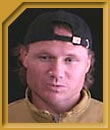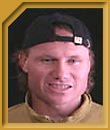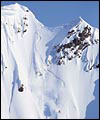




MORE INTERVIEWS
Seth Morrison
Steve Winter
Alex Lowe
John Eaves
Dave Swanwick
Scot Schmidt
Rob DesLauriers
Lynn Hill
Ed Viesturs

| Download a FREE media player to watch it: [Windows Media] [RealPlayer] The Interview  "Filming is just a whole other arena — it's logistics, it's group dynamics, it's shots, it's weather..." | |
 "The whole thing is designed to get kids in the mountains that wouldn't get the chance otherwise..." | |
Making it in the Mountains
It's early morning in Valdez, Alaska. A film crew assembles its quagmire of cameras and gear and heads to the heli-pad where it boards one of the A-Star helicopters operated by Valdez H20 Heli Adventures. Owner and head guide, Dean Cummings, together with the pilot, camera guy and athlete talent lift off into the sky and fly away from Prince William Sound and into the immense mountains of the Chugach Range.
The team is in search of film segments of ski descents that will hopefully captivate the audience and make its sponsors proud. The mission – to capture sick footage while spending the day skiing with friends on some of the most technical and challenging terrain in the world.
| "Working with a film crew, being part of the talent and guiding — with all the variables of the logistics for aircraft, the groups, and the snow safety — it definitely is something that tests you..." — Dean Cummings |
Cummings, who won the World Extreme Skiing Championships in 1995, now spends time behind the scenes as a guide and also in front of the camera as talent. When he's guiding, his primary responsibility is safety: to assess the slope and minimize risk. With the knowledge he has gained through experience, Cummings guides both clients and film crews. To some he is a mentor as fellow pro skier Seth Morrison professes he learned most of what he knows from Dean.
In Global Storming, the latest film by Matchstick Productions, Cummings filmed segments in Alaska and Chamonix, France, where he shot for two weeks during last winter's epic season.
"The most memorable thing about Chamonix was just how much snow fell in the two weeks I was there," says Cummings. "It was unbelievable to see the valley basically just on its knees with this huge storm — avalanches going off up the valley where people lost their lives and homes were destroyed. It was like, wow, what nature can do."
 Dean Cummings |
|
Wearing all the hats in ski film production, too, Cummings said can be difficult. "Working with a film crew, being part of the talent and guiding — with all the variables of the logistics for aircraft, the groups, and the snow safety — it definitely is something that tests you. Guiding really makes you think and puts you in the moment. It adds an extra element to the situation, to have that much going on and to really make you rise to the occasion and deal with it is a pretty cool feeling."
At the top of a peak, Cummings has to wait for the other skiers to go first, but first tracks aren't his job when he's guiding. He still gets to pick out a good line and ski it while the camera is rolling. According to Cummings, both jobs require an incredible amount of focus. When asked which he likes better, the role of guide or skier, he says it's a difficult comparison.
"Definitely guiding takes more of a commitment out of your life," he says. "So that's what I'm more committed to is guiding and getting people down the mountain safe. But filming is just a whole another arena — it's logistics, it's group dynamics, it's shots, it's weather, it's all about getting the right day, the right snow, so it's hard to compare the two, they're so different."
| "Definitely guiding takes more of a commitment out of your life, so that's
what I'm more committed to is guiding and getting people down the mountain safe..." |
In the Alaska segment of the movie, Cummings had the home turf advantage where he served as both guide and talent.
Cummings was turned on to the mountains at an early age. As a kid growing up in Los Alamos, New Mexico, home of the atomic bomb, Cummings was admittedly a hellion. When given the choice to take a two-and-a-half-week long backpacking course or get a probation officer, it wasn't a tough choice.
He chose the trip, but didn't expect much until mountain guide, Ken Sims, opened his eyes to the possibilities he suspected existed. Cummings was inspired by the achievements and attitude of Sims, who led him into the mountains as part of a "Hoods in the Woods" program.
Before that trip, Cummings had hoped it was possible to live his life in the mountains, but he didn't receive much support. People told him to focus on a career in business, or anything more traditional — no way could he ever earn a living in the mountains.
"They always knocked me off the stool of, 'I want to make my living in the mountains,' and they were like, 'it's not a reality, so be careful what you do there,'" Cummings says.
Then during the backpacking trip, Sims would wake him up at 5:00 in the morning and say "Hey, come on, let's go rock climbing."
"Ken kind of took me under his wing and I just realized, 'wow, this guy has a great life.' And it is possible to make a living in the mountains, and that's something I never got in school," he explains.
|
"...it
is possible to make a living in the mountains, and that's something I never got in
school..." |
The goal of "Experience the Mountains" is to provide opportunities for young people who live in mountain communities to experience and learn about the environment around them through recreational opportunities, with a special focus on the learning aspect of it. Organizers want kids to learn safe practices, especially for backcountry skiing and mountaineering kinds of activities. "Experience the Mountains" also teaches kids about the sensitivity of the environment and the relationship between them as individuals in the community and the environment. The kids learn about community-based responsibility through developing projects, for example trail maintenance, or acting as big brothers and sisters to pass these values on to others.
"The idea is to give these kids outlets beyond the usual things that they might find," says Joel Serra, spokesperson for the program. "It's amazing how many of these kids grow up in close proximity to these opportunities and still don't know much about them, so we're just trying to open their eyes."
According to Cummings, the organization donated funds to the Taos Pueblo last year, giving 21 kids the chance to ski five times. The goal this year is to get kids up on the mountains once a week for the entire ski season. And they have to earn the chance to ski by achieving goals, such as getting good grades or helping out in their communities.
"It makes them step up to the plate and the whole goal in this thing is to open up a whole new window for these kids to realize there is potential in the mountains to make a living — and the mountain is their backyard, so that's a whole lot more realistic to them than going to a university or going somewhere else to make a living," says Cummings.
Just as he was turned on to the mountains by somebody who took him under his wing, Cummings is trying to do the same for young kids. The idea is to show them they can be lift operators, ski patrollers, mountain managers, or pro skiers or snowboarders, for instance.
Though he shunned mainstream living, Cummings did end up starting his own business — and it just happened to align with his passion for skiing. He's moved to Alaska to run Valdez H20 Heli-Adventures and, so far, more snow has fallen thus far this season than has for the last five years. In growing the business, H20 has added new GPS Photo Log and a new aircraft, which total three helicopters at max operation. And when he's not guiding, Cummings works with sponsors like Salomon, Kavu and Boulder Gear, the latter of which has just launched a Cummings clothing line.
All Cummings needed was a role model to prove his point. "To meet this guy and see it happening, it was like, 'cool, this is it.'"
— Michelle Quigley, MountainZone.com staff